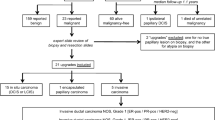Abstract
Purpose
To determine the significance of small, often mammographically occult and asymptomatic papillomas of the breast 15 mm and smaller.
Methods
Four-year retrospective review of papillomas of the breast in a community-based dedicated breast imaging center, with a selected cohort of 179 papillomas 15 mm or smaller in 147 patients, all completing image-guided core biopsy followed by surgical excision.
Results
Of 179 papillomas 15 mm or smaller, 36 % were abnormal (24 % atypia; 12 % cancer). Twenty-one percent had a surgical upgrade diagnosis. One hundred forty-six benign papillomas by core biopsy yielded 7 (4.7 %) cancers and 25 (17 %) atypias (atypical ductal hyperplasia (ADH), atypical lobular hyperplasia (ALH), or lobular carcinoma-in situ) at surgical excision. Seven of 34 (14 %) of very small papillomas (5 mm or smaller) showed cancer. Twelve of 72 (11 %) and 8 of 36 (13 %) papillomas showed cancer in normal-risk and high-risk patients, respectively. Increasing age (70+ years) associated strongly with increasing risk of papillomas with cancer (10 of 35, 29 %). Thirteen unsuspected papillomas in 10 patients with new nonpapillary breast cancers yielded 3 atypias and 3 additional cancers, changing surgical management in half of these patients. Breast ultrasound identified 44 % of papillomas as incidental findings, all mammographically occult and asymptomatic.
Conclusions
There is no size threshold below which a papilloma of the breast can be safely watched or ignored without risking a missed diagnosis of atypia or cancer. Identification of papillomas in patients with new nonpapillary breast cancers can change patient management in up to half of these patients. Finally, breast ultrasound significantly enhances identification of unsuspected papillomas.






Similar content being viewed by others
References
Youk JH, Kim EK, Kwak JY, Son EJ, Park BW, Kim SI. Benign papilloma without atypia diagnosed at US-guided 14-gauge core-needle biopsy: clinical and US features predictive of upgrade to malignancy. Radiology. 2011;258:81–8.
Chang JM, Moon WK, Cho N, et al. Risk of carcinoma after subsequent excision of benign papilloma initially diagnosed with an ultrasound (US)-guided 14-gauge core needle biopsy: a prospective observational study. Eur Radiol. 2010;20:1093–100.
Chang JM, Moon WK, Cho N, et al. Management of ultrasonographically detected benign papillomas of the breast at core needle biopsy. AJR Am J Roentgenol. 2011;196:723–9.
Jaffer S, Nagi C, Bleiweiss IJ. Excision is indicated for intraductal papilloma of the breast diagnosed on core needle biopsy. Cancer. 2009;115:2837–43.
Rizzo M, Lund MJ, Oprea G, Schniederjan M, Wood WC, Mosunjac M. Surgical follow-up and clinical presentation of 142 breast papillary lesions diagnosed by ultrasound-guided core-needle biopsy. Ann Surg Oncol. 2008;15:1040–7.
Ueng SH, Mezzetti T, Tavassoli FA. Papillary neoplasms of the breast: a review. Arch Pathol Lab Med. 2009;133:893–907.
Skandarajah AR, Field L, Mou AYL, et al. Benign papilloma on core biopsy requires excision. Ann Surg Oncol. 2008;15:2272–7.
Rizzo M, Linebarger J, Lowe MC, et al. Management of papillary breast lesions diagnosed on core-needle biopsy: clinical pathologic and radiologic analysis of 276 cases with surgical follow-up. J Am Coll Surg. 2012;214:280–7.
Bernik SF, Troob S, Ying BL, et al. Papillary lesions of the breast diagnosed by core needle biopsy: 71 cases with surgical follow-up. Am J Surg. 2009;197:473–8.
Shouhed D, Amersi FF, Spurrier R, et al. Intraductal papillary lesions of the breast: clinical and pathological correlation. Am Surg. 2012;78:1161–5.
Liberman L, Tornos C, Huzjan R, Bartella L, Morris EA, Dershaw DD. Is surgical excision warranted after benign, concordant diagnosis of papilloma at percutaneous breast biopsy? AJR Am J Roentgenol. 2006;186:1328–34.
Swapp RE, Glazebrook KN, Jones KN, et al. Management of benign intraductal solitary papilloma diagnosed on core needle biopsy. Ann Surg Oncol. in press.
Li X, Weaver O, Desouki MM, et al. Microcalcification is an important factor in the management of breast intraductal papillomas diagnosed on core biopsy. Am J Clin Pathol. 2012;138:789–95.
Holley SO, Appleton CM, Farria DM, et al. Pathologic outcomes of nonmalignant papillary breast lesions diagnosed at imaging-guided core needle biopsy. Radiology. 2012;265:379–84.
Bennett LE, Ghate SV, Bentley R, Baker JA. Is surgial excision of core biopsy proven benign papillomas of the breast necessary? Acad Radiol. 2010;17:553–7.
Disclosure
The authors declare no conflict of interest.
Author information
Authors and Affiliations
Corresponding author
Rights and permissions
About this article
Cite this article
Glenn, M.E., Throckmorton, A.D., Thomison, J.B. et al. Papillomas of the Breast 15 mm or Smaller: 4-Year Experience in a Community-Based Dedicated Breast Imaging Clinic. Ann Surg Oncol 22, 1133–1139 (2015). https://doi.org/10.1245/s10434-014-4128-1
Received:
Published:
Issue Date:
DOI: https://doi.org/10.1245/s10434-014-4128-1




